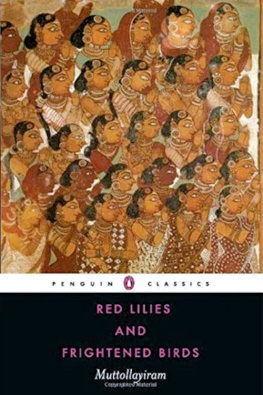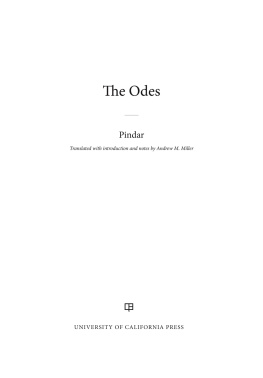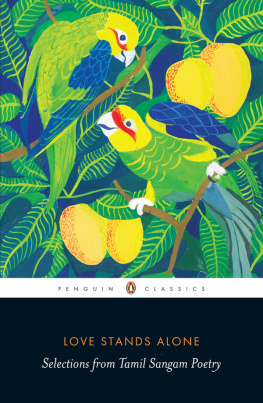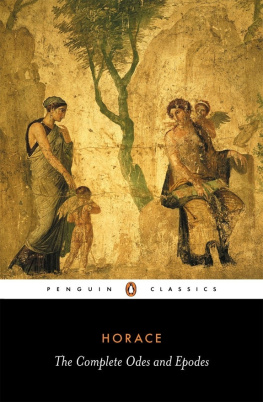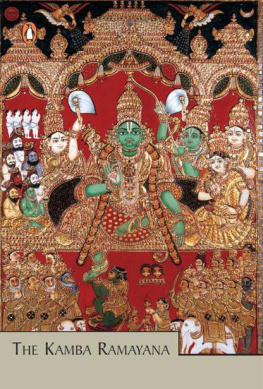Red Lilies and Frightened Birds
Muttollayiram
Translated from the Tamil by
M.L. Thangappa
Edited and introduced by
A.R. VENKATACHALAPATHY

PENGUIN BOOKS

RED LILIES AND FRIGHTENED BIRDS
M.L. T HANGAPPA (b. 1934) was born in Kurumpalapperi, Tirunelveli district, Tamilnadu. Educated at St Johns College, Palayamkottai, he taught Tamil for over twenty-five years in the various colleges of the Puducherry government until his retirement in 1994. He served on the editorial board of the Tamil monthly Thenmoli (196267). An accomplished poet, his books in Tamil include Adichuvadukal, Uyirppin Athirvukal, Ethu Valkai? and Nunmaiyai Nokki. His translations from Tamil literature into English range from Sangam poetry and didactic poetry to the songs of St Ramalingam, Subramania Bharati, and Bharatidasan. He has won the Bharatidasan Award (1991) of the Government of Tamilnadu, and the Sirpi Literary Award (2007) for lifetime achievement in poetry. Active in the Tamil language rights movement, he is also a founding member of the Puducherry Ecological Society. His translations from the Tamil classics have appeared in Penguin as Love Stands Alone: Selections from Tamil Sangam Poetry. Thangappa lives with his family in Puducherry.
A.R. V ENKATACHALAPATHY (b. 1967) studied in Chennai and took his PhD in history from the Jawaharlal Nehru University, New Delhi. Now professor at the Madras Institute of Development Studies, Chennai, Chalapathy has taught at universities in Tirunelveli, Chennai and Chicago, and has held research assignments at Paris, Cambridge and Harvard. He has published widely on the social, cultural, and intellectual history of colonial Tamilnadu, both in Tamil and in English. His publications include In Those Days There Was No Coffee: Writings in Cultural History, The Province of the Book: Scholars, Scribes, and Scribblers in Colonial Tamilandu, a translation of Sundara Ramaswamys J.J.: Some Jottings, as well as the edited volumes Chennai, Not Madras, and In the Tracks of the Mahatma: The Making of a Documentary. He has also edited M.L. Thangappas Love Stands Alone: Selections from Tamil Sangam Poetry.
for
Visalakshi Thangappa
and
Anitha Chalapathy
The land of Kothai,
deft wielder of a deadly spear
with poison-tipped, leaf-shaped head,
knows no turmoil
except that
caused by the water birds.
For when the red lilies
bloom in the waterlogged fields,
the birds panic,
thinking the water is on fire.
They fly helter-skelter,
trying to guard their nestlings
under their wings.
Introduction
Of Spears and Bangles
That Tamil is a classical language is now a commonplace in the scholarly world. However, its living and unbroken literary tradition of over two millennia remains unrecognized to a large extent. Widely anthologized and translated, Tirukkural and Sangam poetry have come to stand for the entire corpus of classical Tamil poetry and didactic wisdom. In truth, the Tamil poetic tradition has much more to offer. With its brilliance and variety Muttollayiram presents an ideal text from which to launch further poetic forays into the landscape of Tamil poetic imagination.
Literally, Muttollayiram could mean either three nine-hundreds (of poems) or nine hundred (poems) on the three (monarchs). Unfortunately, given the fact that only some 130 of them survive, the numbers themselves are a subject of another debate, and even the meaning of the ambiguous title has evoked considerable controversy. For a long time it was thought that Muttollayiram consisted of 2,700 poems with 900 on each monarchan erroneous view that some hold on to even now. However, even by the standards of Tamils bad luck where a large corpus of writings has been wiped out by calamities such as tsunamis, bigotry, and apathy, it is somewhat far-fetched that only about a hundred out of 2,700 should survive. The confusion about the actual numbers was ultimately cleared by S. Vaiyapuri Pillai, the enormously erudite if controversial scholar, who cited two grammatical texts, Ilakkana Vilakka Pattiyal and Prabandha Deepikai, which refer to a genre called Thollayiram that consists of 900 poems.
Therefore, it is now clear that Muttollayiram consists of 900 poems in all, with 300 each devoted to a monarch hailing from one of the three Tamil dynastiesCheras, Cholas and Pandyas. The bulk of them (108 plus an invocatory poem) come from a fifteenth-century anthology of puram poems, Purathirattu; quotations from medieval commentaries account for the rest. Poems from Muttollayiram have been cited or quoted in a variety of pre-colonial commentaries of mostly grammatical texts, indicating its continued importance in Tamil literary culture. It is evident that Muttollayiram is not an anthology but a unified work by a single author who, however, is anonymous, with neither written record nor even oral tradition to throw a single shaft of light upon his identity. Like all Tamil literary texts, the dating of Muttollayiram is a subject of debate. Based on internal and external evidence, S. Vaiyapuri Pillai dated it to the early part of the ninth century CE while T.V. Sadasiva Pandarathar dated it to the sixth century. As we shall see below the earlier date is more plausible.
It was not until 1905 that these poems were first culled from Purathirattu by Ra. Raghavaiyangar and published separately. The credit for drawing attention to the exquisite poetic qualities of Muttollayiram and celebrating it should go to T.K. Chidambaranatha Mudaliar (18811954), the renowned connoisseur of poetry. Since then, despite their meagre quantity, these poems have captured the hearts of the cognoscenti and been frequently reprinted and glossed. Muttollayiram has also been translated at least twice into EnglishP.N. Appuswami (1977) and A.V. Subramanian (1984); into SanskritA.V. Subramanian (1993); and into HindiS. Subramanian (1996). There is also a German study of the text by Ulrike Niklas (1987).
Why should this book of hundred-odd poems, admittedly incomplete, capture the fancy of Tamil readers and warrant a new English translation? Readers familiar with Sangam poetry will easily recognize the setting and the themes of Muttollayiram. The conventions of akam and puram mingle almost seamlessly, extending the elaboration of Sangam themes to their limits.
Coming centuries after the flowering of Sangam poetry, the earliest corpus of Tamil literature, Muttollayiram nevertheless presents many continuities. The Chera, Chola and Pandya kings, who are even mentioned in the second and thirteenth rock edicts of Ashoka (third century BCE ), and still somewhat nascent in the Sangam age, emerge in Muttollayiram as full monarchs in all their glory. A number of terms for rulerssuch as irai, ko, kilavan, velir, kurisil, kottram, mannan, arasu, and ventaroccur in the more ancient corpus dated to the cusp of the Common Era. The usage of these terms, the Marxist Tamil scholar K. Sivathamby observes, is often marked by considerable flexibility; but this flexibility is seen only in the case of those who go high up in the ladder of the authoritative position.

